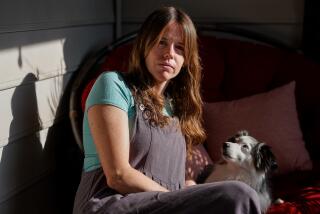Dramatic Changes
Aspiring gondoliers go to Venice.
Aspiring actors come here.
For the record:
12:00 a.m. June 19, 1997 For the Record
Los Angeles Times Thursday June 19, 1997 Valley Edition Calendar Part F Page 50 Zones Desk 2 inches; 64 words Type of Material: Correction
Acting school--In a story on acting school in the June 12 Calendar Weekend, a screenplay called “The 4” was characterized inaccurately. As writer-director David Portlock clarified, the film is “a religious metaphorical fable” involving “four L.A. hipsters sent by Satan” to collect on a debt owed by God. A shorter version was well received at Sundance. In captions for the same story, the names of students Mychal Wilson and Geno Taylor were transposed.
On a recent Sunday evening, more than a dozen student actors sit attentively in a too warm room on the second floor of a Studio City office complex.
Two by two, the students get up and gamely practice their nascent craft, under the kind but critical eye of Ken Lerner, a working actor who runs one of a dozen acting programs currently flourishing in the Valley.
Lerner is one of those people who works often enough to look familiar but who is not so famous that you remember where you saw him last.
Since he came to Hollywood 21 years ago, he has been in dozens of movies and even more episodic TV. Routinely cast as a Jewish professional, he played the lawyer friend who sticks by Kurt Russell in “Unlawful Entry.” He is the deceitful executive who claims he never got the package in an oft-seen commercial for Federal Express. He has a recurring role as the head of an HMO on the medical drama “Chicago Hope.”
He is also an experienced teacher, who, as a substitute, used to go into tough schools in his native Brooklyn and “try to be a stand-up comedian to keep them in their seats.”
Lerner knows firsthand that a great teacher can change an actor’s life. He studied with the legendary Stella Adler and later with giant Roy London. London, who died in 1993 of complications of AIDS, was “a fabulous teacher and mentor,” Lerner says.
Many other actors would agree, including Forest Whitaker, Michelle Pfeiffer, Brad Pitt and Geena Davis, who thanked London when she won her Oscar for “The Accidental Tourist.”
In the last few years, the way acting is taught has changed dramatically in the capital of acting. Once taught by well-known studios or seasoned actors who had established their bona fides, classes are now increasingly offered by casting directors and others who have little or no formal training in theater. They may have valid tips on how to ace a cold reading and catch a casting director’s eye, but some wonder if charging actors to audition doesn’t constitute conflict of interest.
At the same time, more traditional schools of acting remain strong in the Valley, in public school magnet programs, college programs and such local institutions as the Sanford Meisner Center for the Arts in North Hollywood and Playhouse West in NoHo, where “Lost World” star Jeff Goldblum teaches a popular weekly course in improvisation.
As a teacher, Lerner works in an eclectic, post-Method tradition that emphasizes acting as a craft in which doing the work can lead to performances marked by ease, depth, texture and sometimes magic.
As he is quick to tell you, he isn’t one of the “beautiful people and football stars” who often find work in Hollywood. “I’m a character actor and I have to earn my parts.”
The format for Lerner’s Sunday night class is to have six pairs of students perform a scene, chosen by Lerner. (Pairs work better than singles because “people spark each other,” he says.) He then gives them “notes,” specific suggestions on how each scene can be improved. The course costs $180 a month, and students get to polish at least two scenes during that period.
Sunday night, Rachel Anderson and Mark Jacobs are first up, doing material from the 1993 film “Mad Dog and Glory.”
In the Uma Thurman role, Anderson has just been given by her gangster lover to Jacob’s character as thanks for a favor (Robert De Niro preceded Jacobs in the movie version).
In the traditional parlance of acting classes, this is Second Work. Anderson and Jacobs have already performed the scene in an earlier class. That First Work was critiqued, and the student actors have incorporated Lerner’s suggestions and their own new insights into this revised version.
Lerner expects his students to grow in the course of the class, and so he addresses their weaknesses as well as their strengths. “A woman who is having trouble with love scenes will get love scenes,” he explains.
For this scene, Lerner has paired the handsome but relatively inexperienced Jacobs with Anderson, a confident performer who has done everything from Shakespeare in Griffith Park to “The Fresh Prince of Bel Air.” Jacobs says he is happy to work with someone who makes him stretch.
For the 10 minutes of their scene, the actors are in a world that first existed in a writer’s imagination, but that will come to life only if they can animate it with the emotional truths of the real world.
As Glory, Anderson tries to talk Jacobs’ unassuming cop out of throwing her out of his apartment, thus incurring the wrath of the thuggish Frank. Jacobs has the daunting task of both remembering his lines and convincing the audience, mostly nonverbally, that he is a quiet man who is both attracted to Anderson and appalled by the circumstances that have put her on his sofa.
Lerner’s notes follow.
“I’m still having trouble with the Fourth Wall,” he says. He wants Jacobs to perfect his ability to perform as if he faced not a camera or an audience, but a real wall--to find the inner resources and hone the skills that will allow him to simulate comfortably and with conviction.
“I still don’t feel the place is yours,” Lerner says of the character’s apartment, created by means of a few simple props carefully chosen by the actors. “This is your house. Feel free to walk around in it.”
Lerner also reminds Jacobs to think of his character in the first person--not “he’s a nice guy” but “I’m a nice guy. I want her out, but I’m not going to take her and throw her out.”
Anderson, too, is counseled on how to strengthen her performance. She has bustled winningly around the make-believe apartment, proffering cheese nibbles and otherwise working overtime to win Jacobs over. Lerner suggests she be even more adorable.
“She’s an actress, a little bit,” he says of the character. “She does what she needs to to get him to go along.”
Not in the scene, but crucial to how effectively the young actors play it, is the character of the bad guy, Frank or Mad Dog (Bill Murray in the film).
Lerner urges his students to tap their personal caches of experience and strong emotion when playing a role they do not intuitively understand.
“Do we have a good Inner Object for Frank?” Lerner asks the class.
“O.J.?” a student proposes.
In the course of the next four hours, four other pairs get up and do their stuff. Like every public performance, theirs are acts of courage.
Lerner corrects, but gently. He gives the candid feedback the students need if they are ever to master their craft, let alone swim with the Hollywood sharks, but he does it without crushing egos.
In Lerner’s view, class should be a safe place where there are no mistakes, only learning experiences.
“A class is about failing, not about being fabulous,” he says. “A class is about taking chances.”
“It’s a nurturing class,” he adds. “That’s the way I was taught.”
Lerner has a parent’s knack for balancing the negative with the positive. When Linda Raths appears with Robert Jaffe in a scene from “Some Like It Hot,” Lerner advises her to dress more like the woman who owned the role, Marilyn Monroe. Any hint that Raths’ performance was less sexy than that of her predecessor is immediately undone by Lerner’s lavish praise.
“I love your rhythms,” he tells Raths. “There’s something about the way you deliver lines that’s just delicious.”
Later in the evening, Lerner suggests ways that Amy Edlin might sharpen her performance in a bit from “Goodbye, Charlie,” a hoary comedy in which she plays a philandering man who is murdered by an indignant husband and comes back to life as a woman.
In playing the scene, in which Charlie, in gown and pearls, goes unrecognized by his former lover (Teri Ozols), Edlin is advised: “You need to be sexually lusting after her and realize that you don’t have what it takes anymore, and what a cruel joke!”
Lerner wants her to explore the comic possibilities of suddenly knowing the realities of both genders. Experiment with high heels. Wear jockey shorts. And Lerner suggests an emotionally charged alternative to the pistachios Edlin has brought onto the set.
“I would have walnuts and smash them with your hands!”
Mychal Wilson and Geno Taylor work on a scene from a movie they hope to start shooting this summer. Called “The 4,” it deals with the alleged CIA role in the crack cocaine traffic in South Central Los Angeles. A shorter version was well received at Sundance, Wilson says.
All scenes are about love or power, Lerner teaches. The scene from “The 4” is clearly about power, as the two young men try to establish who is brighter, who is stronger, who is the Big Dog.
“If you make it a chess match, it will work very well,” Lerner promises.
Wilson’s character is writing a book on a laptop when Taylor’s character enters.
“Geno, I’d like to see you invading his space. Writers don’t like people looking over their shoulders.”
Wilson’s character drinks wine; Taylor’s, beer. Explore the class differences those choices imply, Lerner urges.
At one point, the decidedly unfilial brothers simultaneously draw their guns. Always check weapons before using them as props, Lerner warns, recalling that a student was once fatally shot in an acting class (not one of his). And feel free to underplay the O.K. Corral moment.
“The gun does the work. You don’t have to go strong at that point.”
As the students prepare to cede the stage, Lerner asks them to make sure they give him an up-to-date copy of the script.
Always the actor as well as the teacher, Lerner jokes, “There might be a rabbi part in it for me.”
BE THERE
The Ken Lerner Studio in North Hollywood can be reached at (818) 753-7744. The Sanford Meisner Center for the Arts is at 5124 Lankershim Blvd., North Hollywood; (818) 509-9651. Playhouse West is at 4250 Lankershim Blvd., North Hollywood; (818) 506-6345.
More to Read
The biggest entertainment stories
Get our big stories about Hollywood, film, television, music, arts, culture and more right in your inbox as soon as they publish.
You may occasionally receive promotional content from the Los Angeles Times.










